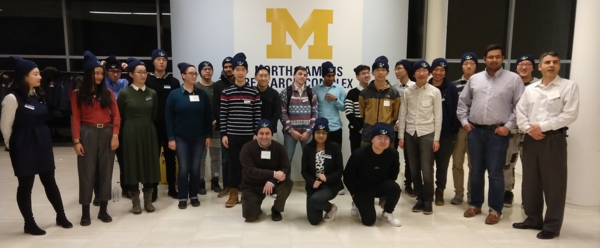Difference between revisions of "SOCR News MDS 2020 BigData"
(→Logistics) |
(→Logistics) |
||
| (3 intermediate revisions by the same user not shown) | |||
| Line 7: | Line 7: | ||
* '''Date/Time''': September 13, 2020, 14:00-15:30 US ET (GMT-4) | * '''Date/Time''': September 13, 2020, 14:00-15:30 US ET (GMT-4) | ||
* '''Presenter''': [https://www.socr.umich.edu/people/ Ivo D. Dinov], and [https://www.med.upenn.edu/apps/faculty/index.php/g275/p8639958 Allison Willis (UPenn)] | * '''Presenter''': [https://www.socr.umich.edu/people/ Ivo D. Dinov], and [https://www.med.upenn.edu/apps/faculty/index.php/g275/p8639958 Allison Willis (UPenn)] | ||
| + | * '''Video Stream''': [https://app.sli.do/event/zvpmop62/live/questions live video stream] and [https://www.pathlms.com/mds archived videos for the 2020 MDS Congress, including this Big Data Session (#601)] | ||
* '''Learning Objectives''': | * '''Learning Objectives''': | ||
** Describe the concept of big data analytics and the impact in clinical research in the field of movement disorders | ** Describe the concept of big data analytics and the impact in clinical research in the field of movement disorders | ||
| Line 16: | Line 17: | ||
==Abstract== | ==Abstract== | ||
| − | This talk will present the pillars and rationale of Big Neuroscience Data and Open Science. We will focus on the important characteristics of biomedical and health challenges and sharing of sensitive information. We will review some case-studies illustrating applications to Neurodegenerative Disease (Parkinson’s disease) and Population Census-like Neuroscience (UK Biobank). | + | This talk will present the pillars and rationale of Big Neuroscience Data and Open Science. We will focus on the important characteristics of biomedical and health challenges and sharing of sensitive information. We will review some case-studies illustrating applications to Neurodegenerative Disease (Parkinson’s disease) and Population Census-like Neuroscience (UK Biobank). Particularly, we will show some sources of Big Neuro Data, illustrate how it can be deidentified, desensitized, shared and utilized for diagnostic detection, tracking and prediction. |
| + | |||
| + | : [https://socr.umich.edu/docs/uploads/2020/Dinov_MDS_BigDataNeuroscience_2020_sm.pdf PDF Slidedeck]. | ||
==References== | ==References== | ||
Latest revision as of 13:48, 13 September 2020
Contents
SOCR News & Events: What is Big Neuro Data? Where is it? How to Use it? Why is it Important?
Logistics
- Event: 2020 Movement Disorders Society Congress, Special Topics Session (601: Big Data Analytics in Clinical Research for Movement Disorders)
- Program: MDS 2020 Congress Program
- Date/Time: September 13, 2020, 14:00-15:30 US ET (GMT-4)
- Presenter: Ivo D. Dinov, and Allison Willis (UPenn)
- Video Stream: live video stream and archived videos for the 2020 MDS Congress, including this Big Data Session (#601)
- Learning Objectives:
- Describe the concept of big data analytics and the impact in clinical research in the field of movement disorders
- Discuss findings from studies based on big data analytics, and their potential implications in the clinical management
Abstract
This talk will present the pillars and rationale of Big Neuroscience Data and Open Science. We will focus on the important characteristics of biomedical and health challenges and sharing of sensitive information. We will review some case-studies illustrating applications to Neurodegenerative Disease (Parkinson’s disease) and Population Census-like Neuroscience (UK Biobank). Particularly, we will show some sources of Big Neuro Data, illustrate how it can be deidentified, desensitized, shared and utilized for diagnostic detection, tracking and prediction.
References
- Dinov, ID, Heavner, B, Tang, M, Glusman, G, Chard, K, Darcy, M, Madduri, R, Pa, J, Spino, C, Kesselman, C, Foster, I, Deutsch, EW, Price, ND, Van Horn, JD, Ames, J, Clark, K, Hood, L, Hampstead, BM, Dauer, W, and Toga, AW. (2016) Predictive Big Data Analytics: A Study of Parkinson's Disease using Large, Complex, Heterogeneous, Incongruent, Multi-source and Incomplete Observations. PLoS ONE, 11(8):1-28, e0157077. DOI: 10.1371/journal.pone.0157077.
- Fu KA, Nathan R, Dinov I, Li J, Toga AW. (2016) T2-Imaging Changes in the Nigrosome-1 Relate to Clinical Measures of Parkinson’s Disease. Frontiers in Neurology, 7(174):1-27. DOI: 10.3389/fneur.2016.00174.
- Gao C, Sun H, Wang T, Tang M, Bohnen NI, Müller MLTM, Herman, T, Giladi, N. Kalinin, A, Spino, C, Dauer, W, Hausdorff, JM, Dinov, ID. (2018) Model-based and Model-free Machine Learning Techniques for Diagnostic Prediction and Classification of Clinical Outcomes in Parkinson’s Disease, Scientific Reports, 8(1):7129. DOI: 10.1038/s41598-018-24783-4 2018.
See also
- SOCR Website
- SOCR-MDP-2020 Projects
- SOCR Navigators
- SOCR Datasets and Challenging Case-studies
- Electronic Textbooks: Probability and Statistics EBook, Scientific Methods for Health Sciences, Data Science and Predictive Analytics
- Hands-on interactive visualization of extremely high-dimensional data (learning module and webapp)
- SOCR News & Events
- SOCR Global Users
- SOCR Home page: http://www.socr.umich.edu
Translate this page:

